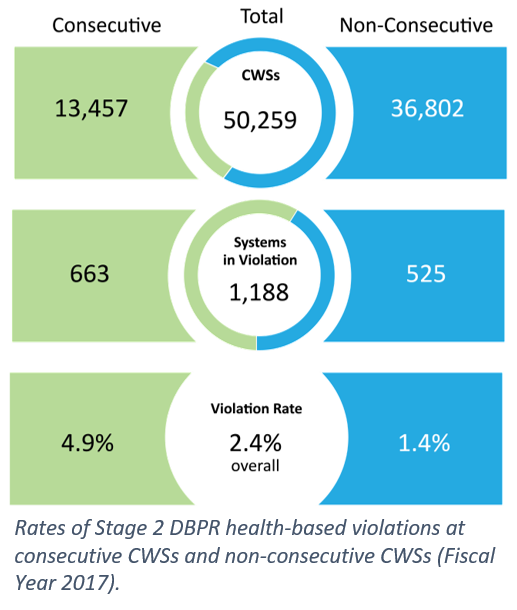Diving Into Regulations
In-Depth Analysis of Drinking Water Rule Implementation
On this page:
- In-Depth Analysis Overview
- In-Depth Analysis: Stage 2 Disinfectants and Disinfection Byproducts Rule and Consecutive Systems Challenge
- In-Depth Analysis Final Report
In-Depth Analysis Overview
The goal of an in-depth analysis of drinking water rule implementation, also known as an In-Depth Analysis, is to review specific regulations to improve how public water systems comply with the Safe Drinking Water Act (SDWA) and protect public health. These national efforts are strategic in scope and are conducted as joint efforts between EPA and the states. EPA and the states work together to:
- Identify SDWA implementation challenges and best practices,
- Develop tools and resources to address challenges, and
- Improve SDWA compliance.
In-Depth Analysis: Stage 2 Disinfectants and Disinfection Byproducts Rule and Consecutive Systems Challenge
The highest number of health-based violations for community water systems (CWSs), in 2017 was the Stage 2 Disinfectants and Disinfection Byproducts Rule (DBPR).
As shown in the figure, more than half of CWSs in violation were consecutive systems.
As part of this collaborative oversight effort, EPA worked with five volunteer state partners to conduct an In-Depth Analysis. These volunteer states were:
- Indiana,
- Kentucky,
- New Jersey,
- North Dakota, and
- Pennsylvania.
Through the Association of State Drinking Water Administrators, EPA also received feedback from 32 other states.
View additional drinking water rule regulations
In-Depth Analysis Final Report
Stage 2 DBPR and Consecutive System Compliance Challenges
These materials summarize the In-Depth Analysis the EPA conducted on the Stage 2 DBPR implementation challenges at consecutive water systems.
The goal of this report is to understand this compliance challenge and identify and share state best practices to better enhance national implementation of the SDWA.
- Final Report: Stage 2 DBPR and Consecutive System In-Depth Analysis (35 pp, 11 K, July 2019, EPA 815-R-19-001, About PDF). This final report describes the challenges and best practices identified in the Stage 2 DBPR and Consecutive System In-Depth Analysis.
- Fact Sheet: In-Depth Analysis: Stage 2 DBPR (2 pp, April 2019, 6MB, EPA-815-F-19-001, About PDF). This fact sheet summarizes the challenges and best practices identified in the Stage 2 DBPR and Consecutive System In-Depth Analysis.
- Fact Sheet: Addressing DBPs in Drinking Water with the Drinking Water State Revolving Fund(4 pp, 910 K, July 2019, EPA 810-F-19-002, About PDF). This fact sheet describes Drinking Water State Revolving Fund (DWSRF) eligibilities related to DBPs. It provides several case studies where DWSRF funds were used for DBP-related activities
